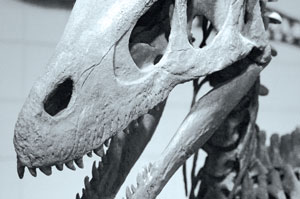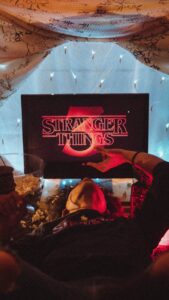Experience time travel at CEU Prehistoric Museum

This archived article was written by: Scott Frederick
As I walked the couple of blocks from my house to the CEU Prehistoric Museum located in downtown Price, fall was in the air. The morning sunlight was warm and the air cool. The sky was a blazing blue, and the leaves and sun bright yellow. I started to get into the mood of the history of our planet and wondered how old the Earth really is. Would my visit to the museum be all about numbers, facts and figures, or would it be a more spiritual experience? I cleared my mind to allow the bones of the dinosaurs to speak to me. All these thoughts and more were going through my mind as I walked into the parking lot of the museum.
The first things you see in the museum parking lot are two menacing looking bronze Utah Raptor sculptures. I got the feeling that if you ever saw a raptor in the wild, and if one was tracking you, death would be a welcome reprieve. At around 1000 pounds, a raptor weighed about as much as a good-sized horse. The muscles in its hind legs were about twice as big as those of a horse. Those hardened muscle were attached to talons the size of a dinner plate. A raptor would make short work of a mere human being.
As I neared the entrance, I stopped to enjoy the copper sculptures flanking each side of the doors. They are lovely 10-foot by four-foot sheets of copper with a hammered texture and perforated with hundreds of little holes in geometric and abstract patterns.
Then I entered the building and the smell of it gave me comfort. It smelled like all museums smell, like an old friend. I told myself to ask the museum’s director, Dr. Reese Barrick, why museums always smell as they do.
Upon entering the lobby, which is also the gift shop, I was greeted cheerfully by Chanel Atwood, who answered all my questions effortlessly. Her 15 years of service to the museum were readily evident. She explained that the museum is open from 9 a.m. until 5 p.m. Monday through Saturday, and closed on Sunday. Admission is $4 for adults, $2 for kids, $10 for a whole family and free for CEU students; what a deal. Most importantly, she indicated where the restrooms were located because the rent on my morning coffee was coming due. I noticed quickly that the whole museum is clean. Even the restrooms looked as if they had just been polished moments before I walked in.
The gift shop was stocked with a colorful assortment of T-shirts, coffee mugs and all things dinosaur. They have a nice selection of hiking books, maps, travel videos and compact discs featuring the music of Native American artists. The music and chanting sound of the Native American artist was softly floating through the museum, which reinforced the feeling of going back in time.
From the gift shop I took a right and headed into the dinosaur exhibit: the Hall of Dinosaurs. This is the moment when I stepped into a time machine and warped back 100 million years. The main exhibit is a large 30 by 50 foot pit of dirt the fossils are mounted in and on. Some are partially covered with dirt. A skylight above the exhibit allowed soft sunlight to illuminate the dinosaur fossils. In one corner of the pit, stands an Allosaurus, which looks like a medium-sized T-Rex. This bad boy is standing on its hind legs with its face pointed towards the ground in a threatening way; and in the posture a mean dog has just before it attacks. In the opposite corner stands a Camptosaurus, another dinosaur that resembles a small T-Rex. And lying down, in what looks to be the position it died in with its skeletal remains stretching from corner to corner of the pit, is a Camarasaurus. This is a dinosaur that looks like a smaller version of a Brontosaurus, the huge plant eater with an enormous body, small head and long neck.
Surrounding the huge fossil pit and on two levels of the museum are dozens of well lit display cases containing dinosaur bones, dinosaur tracks, coalified logs from local coal mines and many, many more objects. Hanging on the walls are pictures of the mine shafts where the fossils and tracks came from.
As Barrick and I sat down in his office, he looked like the kind of person I imagine in charge of a dig site. He is somewhere in his late 30s early 40s, has brownish-reddish, short hair, a full beard speckled with a bit of gray, wire rimmed glasses and wearing jeans and a black polo shirt. He looks like a guy that would be more comfortable on horseback in the middle of nowhere than behind his desk in the museum. As we talked I noticed it took less effort for him to explain complicated answers than it did for me to ask simple questions.
His theory on why museums smell like they do is that all museums are climate controlled to strict specifications that slow down the degradation of their collections. All museums also use the same glues and cements to hold things together. They also use similar chemicals and methods of cleaning and preserving in order to keep their valuable artifacts aging as slowly as possible.
The next thing I wanted to know was how long ago dinosaurs became extinct? He explained it was around 65 million years ago, depending on your perspective. He said it all depends on your perspective because birds evolved from dinosaurs so in a sense, dinosaurs are still around today.
As he was explaining all this, I tried to wrap my mind around the number 65 million. I tried to equate geologic time in human lifetimes. I started calculating in my head, my age times powers of ten. I have been on this earth for 44 spins around the sun. Ten times forty-four is 444. I can understand that number. That puts us back in time to the year 1,600, sometime around when the Mayflower landed in America. So far so good. One hundred of my lifetimes or 100 times 44 is 4,400 years, which puts us back approximately 2,000 years before Christ. I can still somewhat grasp that much time. And how about 1,000 of my lifetimes, or forty two thousand years before Christ? This is where my mind starts having trouble comprehending that much time. But 65 million years? That is about 1.5 million of my lifetimes. That’s an amount of time far beyond my ability to comprehend. So I try to feel the effect these ancient dinosaur bones have on the atoms that make up my body and to sense their subtle whispers.
I wondered what the landscape of Price looked like 65 million years ago. If we walked out of the museum and into the Price of 65 million years ago, what would we see? To my surprise, Barrick told me we would be beneath 100 feet of seawater, and that Price used to be the floor of an ocean. He added that if we went back in time 100 million years, Price would resemble the Florida Everglades with dinosaurs roaming around. The mineralized remains of plants and other organic matter are where our coal beds came from. I asked if the dinosaur tracks on display in the museum were made of coal.
We walked out of his office to examine some of the dinosaur tracks. He showed me how the dinosaur tracks are made of sand that blew into depressions made by the feet of dinosaurs in the mud of the swampy, heavily vegetated area and were then covered with dirt and eventually solidified into sandstone rock. The vegetation of the swamp turned into coal beds with dinosaur tracks being on top of the coal seam. So the tracks themselves are made of sandstone, and surrounded with coal. Still visible in some of the dinosaur tracks are fossilized leaves and other plant material embedded onto them.
As I prepared to leave Barrick’s office I asked him if he had a message for CEU students. He said the students are going to school in a wonderland of geology, paleontology and archeology. Explore it, and if you happen find something which you very likely will, take pictures, mark the location on your GPS, or take detailed notes on the location so you can find it again, don’t disturb anything and inform someone at the museum.
Price is where many dinosaurs lived, right here where we go to school, where we drive our cars, where we eat, where we sleep, where we shop. The dinosaurs were right here. You may have even stepped right where a dinosaur stepped millions of years ago. If you haven’t been to the Prehistoric Museum for a while, it is worth a return trip. If you have never been there, get your calendar, mark a day and go.
There is a lot of information to absorb, so take your time. And in addition to all the numbers, facts and figures, charts and graphs, be open to feelings and sensations. Get close to those ancient bones and touch them. Maybe you will have a flash of intuition that no one else has ever had. Maybe you will have an idea of how those animals lived and what the Earth was like back then. One of these days, grab a friend and head down to the museum. The price is right, and it is the closest you will ever get to taking a trip in a time machine.





Comment
That may be the best article I have ever read about a trip to the museum.
Articles about trips to museums aren’t usually high on my list of things to read, but this author has a wonderful way of engaging readers, bringing them along and interpreting events in a way that immerses the reader in personal dialogue. What could have been boring facts and figures were presented in ways that stimulate imagination and cultivate interest.
Congratulations to Mr. Frederick. I hope he will share more of his adventures with us in the near future.
Jerry Troxel